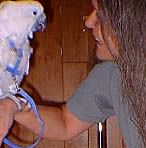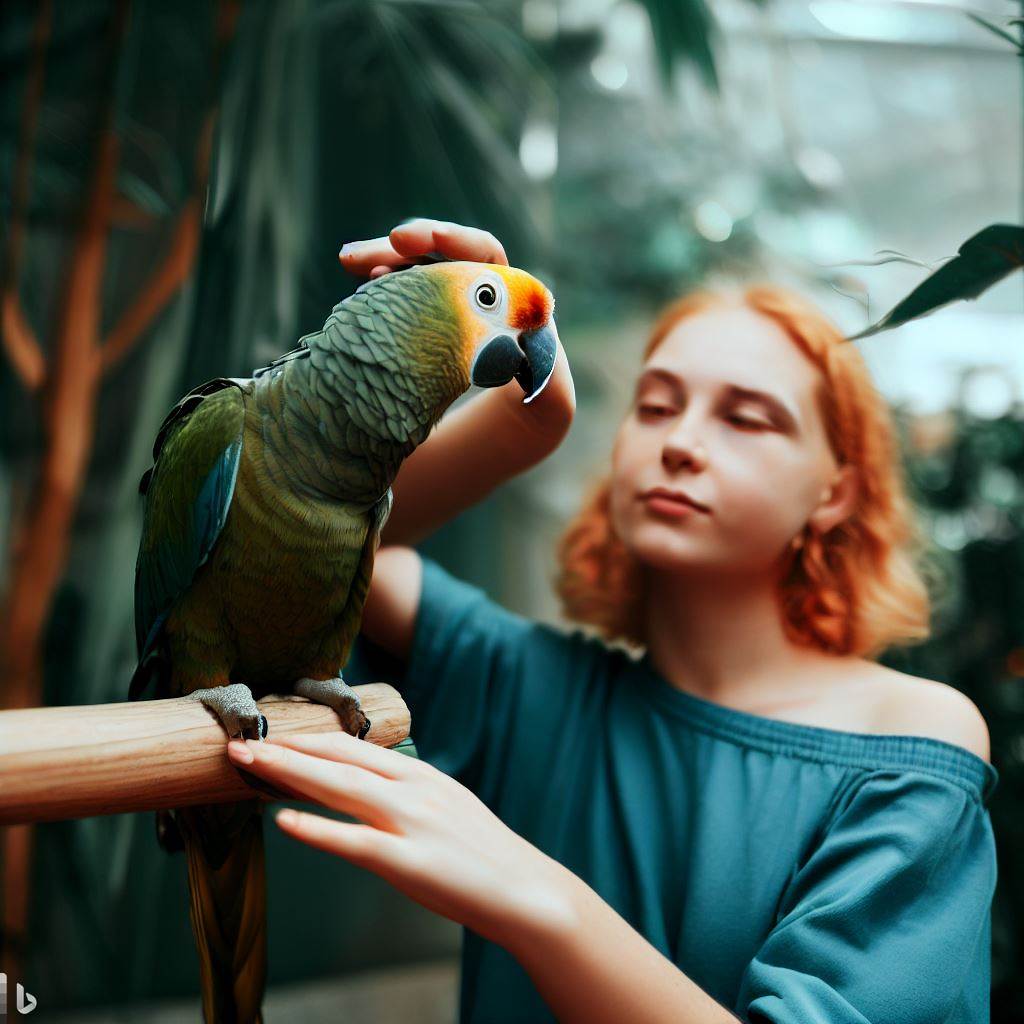
I use a harness on my umbrella cockatoo, Siva, when we leave the confines of the house and enter the wilds outside of our door. All in all I have had three harnesses for him, two of which reside now at the Oasis Sanctuary as part of my in-kind (get it out of here) donation.
The first was a cat harness that I managed to modify for him and which he hated. It was one you can see at your local pet shop for tiny dogs or cats. It was too large, full of metal clips and nearly impossible to attempt to put on an angry cockatoo. It was far too heavy and bulky and the metal clips were delicious, had they been swallowed. The second was beautiful to look at but required that I pull the loop over Siva’s head. This was not only something he would simply not tolerate, but was awkward for him, to say the least, and was difficult to pull on and off due to his crest, fear and impatience. It took Siva less than five minutes to remove the buckle from this harness. The third and final harness was one which clipped around the neck and under each wing. I was certain that Siva would need a large harness, but was assured by the seller that Siva would need a medium. Being stubborn, I ordered a large for my gigantic friend, only to find it enormous. They were happy to take it back and more than willing to replace it quickly with the medium. They were kind enough not to relay an “I told you so” back at me.
Training a parrot to wear a harness would be something I would want to put a great deal of thought into before setting out to do it. It is imperative that one be able to handle his or her parrot before attempting to train . It is preferable that you be able to handle the area under the wings. In any training situation one needs to focus full attention on the parrot using a kind of tunnel vision while maintaining a sensitivity to the bird’s emotions, while relieving them of any fears. Training needs to be done in stages, always ending each session on a positive note, and as Sally Blanchard often suggests, in a neutral room.
I decided to use my studio, far from his cage, where I work with each of the birds. Siva is very aware that this is where we learn, work and in the afternoons, often play. It is important that the bird know his commands. Useful in any training program is positive reinforcement, assurance of well being and safety and “no”, as well as step up and down commands.

Each day I would repeat this only adding that he step up onto my arm while I held the leash in my hand. We would parade about the studio for an increasing amount of time daily, with praise, until this became fun. At the beginning Siva mauled the leash, leaving it less than beautiful, but still very functional. Once he was comfortable in the studio in his harness, we began taking short walks outside. Walk time was increased as he became more at ease and finally the harness was used whenever we would go outside to avoid fly aways or him being swept up in a desert wind or dust devil.
He now associates the harness with a “bye bye” or trip outside, a neighborhood walk, and helps me put it on by lifting his wings. It has become a normal event in the course of his day and a positive experience for both of us.
All birds are not as easy as Siva and may take more time and far more patience. Many people in our instantly gratified society give up too quickly when the bird shows the least bit of resistance to a new idea. Persistence and patience make things happen and the parrot needs to know that you are serious about what you want of them and that you are in charge. This of course needs to be conveyed kindly and calmly always.
All birds are not umbrella cockatoos. The needs of the cockatoo with it’s accurate mechanical skills far exceeds the needs of some of the other parrots. I would not necessarily opt for the same harness for my Congo grey or Amazon.
There are a number of harnesses on the market, advertised in the bird magazines and if you are as lucky as we are, carried in some of the better bird supply stores. Below are some of the makers of the more popular harnesses. I have spoken to people from all three companies and have written comments below based on those conversations.
Charlie Macaw Bird Companion Wear has eight sizes of harnesses ranging in price from $19.95 to $28.50, including shipping. Soon they will add yet another harness for budgies. The harness is fastened with one heavy duty plastic clip and is guaranteed for 30 days free repair for any damage your bird may inflict to it. Rather than simply fixing the harness, the maker will adapt the harness to avoid further breakage, compensating on the design wherever necessary. They were most helpful and told me how they would put on the harness. They set the bird on their knee, hold the back of the head in a parrot grip and slip the harness over the head. Then the strap goes behind the wings and clips together. The clip can be rotated to any position around the bird that you choose. With the exception of the cockatiel and conure sizes the harness is fully adjustable. It is also possible to design a custom harness for your bird as she is open to new ideas.
The Fred Bird Company ‘s harnesses come in six sizes from x-tra small to large, fitting budgies to hyacinths. The x-tra small is different from the others necessitated by the size of the birds. These harnesses are the most lightweight, having the least metal parts, which include one D-ring and a buckle, similar to a belt buckle. The owner of Fred Bird Company says that his company has conducted a safety study which included fifty birds. This harness slips over the head of the parrot. The leash is connected to the D-ring at the chest. The company includes safety tips with the sale of the harness. These harnesses range in price from $14.95 to $23.
Premier Pet Products makes a harnesses called the Feather Tether and sold only through dealers. They are a small husband and wife team who also make humane dog products sold through veterinarians. The harness designs differ with the size of the bird. The petite size uses a black plastic quick snap for smaller birds. The small size uses light snaps on the leash and harness and the mediums and large use heavy duty “baby bolts”. The harnesses are fully adjustable for a comfortable fit. These harnesses are clipped together around the neck rather than pulled over the head and then clipped under the wings. Custom orders are available.
All three of the companies supply the customer with excellent directions for use with the purchase of the items.
A word of caution needs to be added here. An unclipped bird is always at risk. A bird on the shoulder is taking a chance at a facial bite and permanent scarring for the human. Using any product necessitates the use of common sense. Most of all know your bird, work with your bird and think of safety first when you take your bird outside.
So, buckle up out there rather than let your bird be swept away in the moment.

